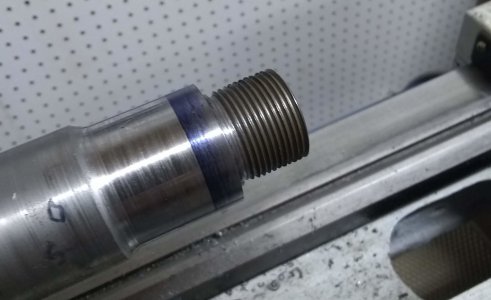- Joined
- Mar 25, 2018
- Messages
- 131
Braking the Code
My PM 1127 lathe came with a manual which, like most import equipment instructions, leaves something to be desired. I have some of it interpreted but I'm stuck, VERY stuck, on the gear change routine for threading. I figured out the"L" is for lowest gear (not in terms of gear ratio but in terms of where it is positioned in the gear chain) and that "H" represents a spacer, but what "spacer" means remains a mystery. Is it a gear put into place to act as a spacer or a shim of some sort? (even though my lathe didn't some with a set of "spacers") Oh yes, "Z" appears to be a Chinese abbreviation for "gear".
At the moment I am setting up to thread a rifle barrel, (1.0625 x 16tpi) The four jaw chuck is centered and the recoil lug is fitted. I am ready to thread. Anyone got a guide that makes sense? And, while I'm at it, if the setup for a 16tpi thread has "Z1" on the backside of Z2 then Z4 can't be on the back side of Z3.
Help .... anyone ...
ADDENDUM:
OK; success. My sincere thanks to all of you who took the time to offer guidance. You reduced my level of frustration immensely and I appreciate it more than I can say here.
This project is a rifle barrel mock up on which I have practiced before actually tackling an actual barrel. Mock ups are cheap, barrels are expensive. The threads are a little rough (I used a HSS cutter and probably cut a bit faster than I should have) but the action and pseudo recoil lug fit beautifully. Thanks again to all who contributed to helping me over this hump.
For those who may not have tried it, I used Joe Pieczynski's method of reverse cutting (lathe spindle and lead screw in reverse with cutter inverted) and it works like a charm.
My PM 1127 lathe came with a manual which, like most import equipment instructions, leaves something to be desired. I have some of it interpreted but I'm stuck, VERY stuck, on the gear change routine for threading. I figured out the"L" is for lowest gear (not in terms of gear ratio but in terms of where it is positioned in the gear chain) and that "H" represents a spacer, but what "spacer" means remains a mystery. Is it a gear put into place to act as a spacer or a shim of some sort? (even though my lathe didn't some with a set of "spacers") Oh yes, "Z" appears to be a Chinese abbreviation for "gear".
At the moment I am setting up to thread a rifle barrel, (1.0625 x 16tpi) The four jaw chuck is centered and the recoil lug is fitted. I am ready to thread. Anyone got a guide that makes sense? And, while I'm at it, if the setup for a 16tpi thread has "Z1" on the backside of Z2 then Z4 can't be on the back side of Z3.
Help .... anyone ...
ADDENDUM:
OK; success. My sincere thanks to all of you who took the time to offer guidance. You reduced my level of frustration immensely and I appreciate it more than I can say here.
This project is a rifle barrel mock up on which I have practiced before actually tackling an actual barrel. Mock ups are cheap, barrels are expensive. The threads are a little rough (I used a HSS cutter and probably cut a bit faster than I should have) but the action and pseudo recoil lug fit beautifully. Thanks again to all who contributed to helping me over this hump.
For those who may not have tried it, I used Joe Pieczynski's method of reverse cutting (lathe spindle and lead screw in reverse with cutter inverted) and it works like a charm.
Attachments
Last edited:




